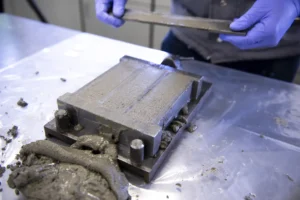

SAFETY FIRST
- If the product comes into contact with the eyes, immediately wash out thoroughly with water and medical advise should be sought.
- Always wear protective clothing to prevent skin irritation or caustic burning, which may result from prolonged contact with cement.
- The use of dust masks is recommended.
- To avoid back injuries when lifting cement bags, bend the knees while keeping the back upright.
1. MATERIALS
CEMENT
Use Ohorongo CEM II B-LL 32.5N cement or Ohorongo CEM II A-LL 42.5N cement, depending on the purpose and function of the concrete.AGGREGATES: SAND
- Sand (particle sizes ranging from fine dust up to 5 mm in size);
- Stone(particle sizes 19 mm, 13.2 mm or 9,5 mm – depending on the purpose and function of the concrete).
WATER
Use clean, drinkable water.
2. MIXING CONCRETE
When mixing concrete, always consider the final purpose of the concrete and choose the appropriate proportions. Refer to the section overleaf for the recommended mix proportions. Machine mixing is preferable to hand mixing. However, if the concrete is mixed by hand, special care should be taken to follow these instructions:
- Ensure you have the correct proportions of cement, aggregate and water at hand;
- Mix the concrete on a clean, hard surface such as a concrete floor or steel sheet;
- Spread the sand in a 10 cm thick layer on the floor or sheet; Spread the cement uniformly over the sand;
- Blend until the cement and sand mixture are of a uniform colour;
- Add the correct amount of stone and blend the mixture until every stone particle is coated.
- Pile the mixture into a heap and make a hole in the middle;
- Add the required amount of clean water in small quantities, blending after each addition until a smooth paste is formed. Too much water will produce weak concrete. Too little will reduce workability and make casting difficult.
- Ideally, the time between the preparation of a batch of concrete and when that batch is placed and compacted should not exceed 90 minutes. Should the concrete not be placed immediately after batching, cover it with plastic sheets or wet sacking, so that it does not dry out in the sun or wind.
WARNING!
If the concrete has hardened and is not workable anymore, that batch of concrete has to be discarded. Do not attempt to mix additional water into the concrete mixture, as this reduces the strength result of the mixture. At any one time, only prepare the amount of concrete that can be used up before the mixture dries out.
PROPOSED MIXED PORTIONS
| CEM II B-LL 32.5N | Bags | Sand | Stone | Volume m³ |
|
HIGH STRENGTH High strength and watertight concrete, driveways and carports |
1 | 1 | 1 | 0.1 m³ |
|
MEDIUM STRENGTH Concrete floors, patios, footpaths, etc. |
1 | 1½ | 1½ | 0.14m³ |
|
LOW STRENGTH Concrete foundations and footings |
1 | 2 | 2 | 0.18m³ |
|
EXTERIOR / DRY MORTAR AND PLASTER mortar and plaster exposed to dampness - mix designs are based on the use of good quality sand |
1 | 2 | - | 0.1m³ |
|
INTERIOR / DRY MORTAR AND PLASTER Mortar and plaster not exposed to dampness - mix designs are based on the use of good quality sand |
1 | 3 | - | 0.14³ |
| CEM II A-LL 42.5N | Bags | Sand | Stone | Volume m³ |
|
HIGH STRENGTH High strength and watertight concrete, driveways and carports |
1 | 1½ | 1½ | 0.1 m³ |
|
MEDIUM STRENGTH Concrete floors, patios, footpaths, etc. |
1 | 2 | 2 | 0.14m³ |
|
LOW STRENGTH Concrete foundations and footings |
1 | 2½ | 2½ | 0.21m³ |
|
EXTERIOR / DRY MORTAR AND PLASTER Mortar and plaster exposed to dampness - mix designs are based on the use of good quality sand |
1 | 2 | - | 0.1m³ |
|
INTERIOR / DRY MORTAR AND PLASTER Mortar and plaster not exposed to dampness - mix designs are based on the use of good quality sand |
1 | 3 | - | 0.14³ |
The volume of the wheelbarrow is 60 litres.
GENERAL REMARKS ON THE USE OF CEMENT
The properties and quality of concrete, mortar- and plaster mixes, in both fresh and hardened states, largely depends on the properties of the materials used.
All aggregates (sand and/or stone) should be clean and dry and not contain clay or organic matter such as leaves, roots or humus. Always store cement and aggregates in a dry place. To avoid moisture rising from the ground, place cement bags on plastic sheeting or a raised wooden platform and cover when necessary to protect against the weather.

